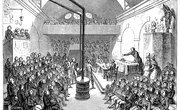Writing an outline helps you organize your ideas into the best order for your paper. You collect a lot of information to write a research paper, and it can be hard to figure out which details you need and how to put them together. Your outline tells you where each piece of information belongs in your paper, and it helps you make sure that every sentence you write is relevant to your topic. Outlining a research paper is simple -- you begin with an introduction, continue with examples or key points, and finish with a conclusion.
Step 1
Decide on the main point of your paper. This will be your thesis statement, which will come at the end of your introduction. For example, if your research paper is about what makes your home state special, your main point might be that the Grand Canyon is your state's most remarkable landmark.
Step 2
Begin your outline by writing the Roman numeral I, then write the word "Introduction" next to it. You don't have to outline your introduction in detail, because it won't have many specific pieces of information in it. Under the word "Introduction," write your thesis statement -- for example, "There are lots of special things about Arizona, but the state is most famous for the Grand Canyon."
Step 3
Think of three key points to write about in your research paper. For the Arizona example, you might decide to write about how the Grand Canyon was formed, the tourists who come to visit it and what other states have similar landmarks, on a smaller scale.
Step 4
Write the Roman numerals II, III and IV on your outline paper, and leave lots of space between each one. Write a title for each key point next to one of the numbers. You don't have to write complete sentences -- a word or short phrase is enough. For example, write "II. History," "III. Tourists" and "IV. Other states' landmarks."
Step 5
Do your research. Read books, articles and websites about the topic of your paper. Look for any details, facts or statistics about your three key points.
Step 6
Write sentences with information your research reveals about your key points -- in your own words -- onto index cards. Use one index card for each piece of information. Write the name of the source, the author and the page number on each card as well.
Step 7
Separate the index cards into three piles, one for each of your key points. Think about what questions the information answers. For example, if one index card says that people visit the Grand Canyon from other states and another card says that people visit from Mexico, both those cards answer the question: "Where do Grand Canyon tourists come from?" Put all the cards that answer the same question together.
Step 8
Write a heading for each major question your cards answer under the Roman numeral for the paragraph. For example, if your cards talk about where tourists come from, how long they stay and what they do while they are at the Grand Canyon, write "A. Tourists' homes," "B. Visit length" and "C. Activities" under "II. Tourists." Leave two or three lines between each letter.
Step 9
Put a number for each specific detail you want to write about under the letter headings. For example, under "A. Tourists' homes," write "1. Other states" and "2. Mexico." Add numbers for all the details until each index card has a place in your outline.
Step 10
Leave a space for your conclusion at the bottom of your outline. Write "V. Conclusion," and write your concluding sentence. This should be something that sums up your main point, such as "The Grand Canyon makes Arizona different from all the other states."
Tip
After you have finished writing your outline, you may still have some index cards that don't seem to have a place in the essay. Put those cards aside. Sometimes essays change, and you might need them later. But for now, they don't help you make your main point, so you shouldn't include them.
Related Articles
References
Tips
- After you have finished writing your outline, you may still have some index cards that don't seem to have a place in the essay. Put those cards aside. Sometimes essays change, and you might need them later. But for now, they don't help you make your main point, so you shouldn't include them.
Writer Bio
Stephanie Mitchell is a professional writer who has authored websites and articles for real estate agents, self-help coaches and casting directors. Mitchell also regularly edits websites, business correspondence, resumes and full-length manuscripts. She graduated from Syracuse University in 2007 with a Bachelor of Fine Arts in musical theater.











